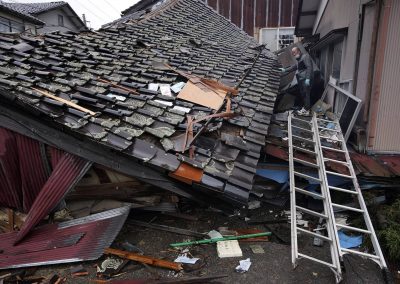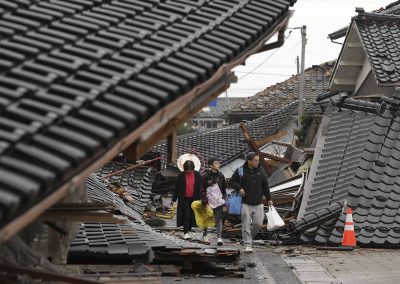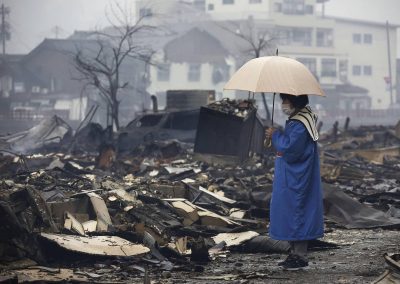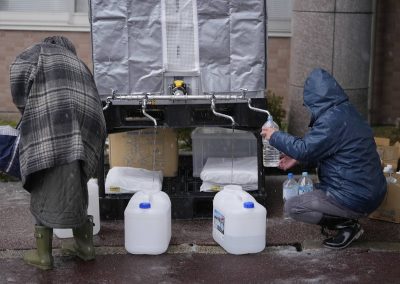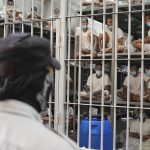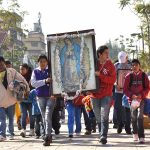
A group of residents of towns near Japanese nuclear plants submitted a petition in February asking regulators to halt safety screening for the restart of idled reactors until damage to a plant that partially lost external power and spilled radioactive water during a recent powerful earthquake is fully examined.
The magnitude 7.6 quake on New Year’s Day and dozens of strong aftershocks in north-central Ishikawa prefecture left 240 people dead and 15 unaccounted for and triggered a small tsunami.
Two idled reactors at Shika nuclear power plant on the Noto Peninsula in Ishikawa suffered power outages because of damage to transformers. Radioactive water spilled from spent fuel cooling pools and cracks appeared on the ground, but no radiation leaked outside, operator Hokuriku Electric Power Co. said.
The damage rekindled safety concerns and residents are asking whether they could have evacuated safely if it had been more severe. The earthquake badly damaged roads and houses in the region.
All Japanese nuclear power plants were temporarily shut down after the 2011 Fukushima nuclear disaster for safety checks under stricter standards. The government is pushing for them to be restarted but the process has been slow, in part because of lingering anti-nuclear sentiment among the public. Twelve of the 33 workable reactors have since restarted.
Residents of Ishikawa and other towns with nuclear plants gathered in Tokyo on Friday and handed their petition to officials at the Nuclear Regulation Authority. They are asking officials to freeze the screening process while damage at the Shika nuclear plant is fully examined and safety measures are implemented.
Susumu Kitano, a Noto Peninsula resident, said there would be no way to escape from his town in case of a major accident at the plant.
Nuclear safety officials have noted that the extensive damage suffered by houses and roads in the area of the Shika plant makes current evacuation plans largely unworkable. The damage, including landslides, made many places inaccessible, trapping thousands of people on the narrow peninsula.
Experts say current nuclear emergency response plans often fail to consider the effects of damage from compounded disasters and need to be revised to take into account more possible scenarios.
Takako Nakagaki, a resident of Kanazawa, about 60 kilometers (35 miles) south of the Shika plant, said the current evacuation plan is “pie in the sky.” Under the plan, residents closer to the plant are advised to stay indoors in case of a radiation leak, but that would be impossible if houses are damaged in an earthquake.
The Noto quake also sparked fear in neighboring Fukui prefecture, where seven reactors at three plants have restarted, and in Niigata prefecture, where the operator of the tsunami-hit Fukushima nuclear plant is preparing to restart its only workable nuclear plant, the world’s largest seven-reactor Kashiwazaki-Kariwa plant.
Hundreds of other residents of towns hosting nuclear plants submitted similar requests to regulators and Prime Minister Fumio Kishida earlier this week.
The Nuclear Regulation Authority has requested a further investigation of the Shika plant, even though initial assessments showed no immediate risk to its cooling functions or outside radiation leaks. NRA officials said Shika’s operator should consider the possibility of additional damage to key equipment as aftershocks continue.
The Shika reactors, inaugurated in 1993 and 2006, have been offline since the 2011 Fukushima disaster. Hokuriku Electric Power has expressed hopes to restart the newer No. 2 reactor by 2026, but reviews of the recent quake damage could delay that plan.
Despite the Fukushima disaster, the government has pushed increasing use of nuclear energy as a source of stable and clean energy.
Prior to the catastrophic magnitude-7.6 earthquake that struck on New Year’s Day, the Noto Peninsula, like many areas across Japan, was witnessing a revival in tourism after the global pandemic. Wajima, a city deeply embedded in Ishikawa Prefecture’s cultural and scenic landscapes, served as a gateway for tourists keen on exploring the region’s artisanal lacquerware traditions, vibrant morning markets, and picturesque rice fields. However, the earthquake’s aftermath has dramatically altered the city’s charm, with its renowned morning market now a site of devastation due to a severe fire triggered by the quake, leaving behind a landscape of destruction and debris.
The disaster claimed the lives of over 200 individuals across the region, including 98 in Wajima alone, with 15 still missing. Nearby Nanao faced its own set of challenges, as the quake’s force left a trail of destruction in its wake, including the historic Ipponsugi-dori shopping street and the iconic Sentai Bridge.
Despite these adversities, local entities like the Nanao Nakanoto DMO remain hopeful yet realistic about the long road to recovery that lies ahead. The organization, known for curating bespoke tours for international visitors, including affluent travelers from France, Canada, and the United States, acknowledges the daunting task of rebuilding in the absence of basic amenities like running water.
Kanazawa, situated south of the epicenter, continues to attract tourists, undeterred by the quake’s impact on neighboring areas. The city’s historic Higashi Chaya district, a hub for cultural tourism, still sees a steady influx of international visitors, highlighting a potential pathway for regional tourism recovery.
Efforts to rejuvenate Wajima’s morning market underscore the community’s resilience. Following advice from a shopping district in Minami-Sanriku, affected by the 2011 Great East Japan Earthquake, local shop owners have initiated a monthly Reconstruction Market (Fukko Marche) to foster business activity and community spirit. This initiative, while modest, symbolizes the indomitable will of the people to overcome the disaster’s aftermath.
The narrative of recovery is punctuated by personal stories of perseverance, like that of Reiko Araki, a local shopkeeper determined to preserve her traditional crafts store despite the earthquake. Her resolve to not succumb to the tragedy and protect the community’s commercial spirit reflects the broader sentiment of the Noto Peninsula’s inhabitants as they navigate the path to reconstruction with optimism and a plea for more structured support from the central government.
In the wake of reconstruction efforts, seawalls have sparked controversy, exemplified by the situation in Ishinomaki City. There, residents relocated to safer, higher ground, while a formidable 10-meter-high seawall stretching over 3 kilometers was erected along a deserted coastline, all at the considerable expense of 12 billion yen. Critics argue against the wall, deeming it superfluous and advocating for the conservation of the area’s natural beauty.
The aftermath of the Noto earthquake has prompted a more cautious approach towards reconstruction and rebuilding efforts compared to reactions following disasters a decade ago. This shift in perspective might be attributed to Japan’s current economic challenges and its demographic trend towards an older population. There’s a growing skepticism regarding the allocation of substantial funds for the restoration of infrastructure, such as roads and water systems, in communities predominantly inhabited by the elderly. These concerns raise critical questions about the future priorities of Japan’s local administrations.
In a tragic start to the new year, a devastating earthquake hit the Noto Peninsula on January 1, claiming the lives of nearly 90 percent of its victims beneath the rubble of their own homes, according to reports from the Ishikawa prefectural government. The aftermath of this calamity revealed the lethal consequences of crushing and suffocation, although officials have refrained from divulging specific details in deference to the families who lost loved ones.
As the recovery efforts progressed, by January 22, the death toll had risen to 233, encompassing both direct and indirect fatalities related to the quake. In a move towards transparency and with the consent of the affected families, the names and ages of 114 victims were shared publicly, alongside the conditions that led to the deaths of 111 individuals. Notably, about 100 of these deaths were a result of homes collapsing on the victims, with the elderly, particularly those in their 70s or older, making up about 60 percent of this group.
The earthquake’s reach extended beyond the immediate wreckage, causing eight fatalities due to landslides and one due to a tsunami. Furthermore, two individuals succumbed to what are suspected to be “disaster-related deaths,” including cases of illness exacerbated by evacuation conditions and injuries incurred during the earthquake.
Investigations conducted by Tohoku University’s International Research Institute of Disaster Science into roughly 400 homes that were either destroyed or damaged in the towns of Nanao and Anamizu revealed a concerning fact: the majority of these buildings were wooden structures erected before 1981, predating the enforcement of modern seismic standards. These standards, established to ensure buildings can withstand earthquakes up to the intensities of upper 6 and 7 on the Japanese scale, were not met by many homes in the affected area.
This deficiency in earthquake resistance was starkly highlighted by the magnitude-7.6 quake that registered at a level 7 in Shika and upper 6 in the towns of Wajima, Suzu, Nanao, and Anamizu. Despite these alarming figures, only 45 percent of Wajima’s homes and 51 percent of Suzu’s residences complied with current seismic regulations as of fiscal years 2022 and 2018, respectively—substantially lower than the national average of 87 percent in 2018.
The challenge of upgrading homes to meet safety standards is compounded by the financial burden it places on the aging population of the Noto Peninsula. As reported by the prefectural government, an estimated 37,000 homes suffered damage or were destroyed by January 22, although more precise data from the hardest-hit regions remains pending.
This event is a grim reminder of the vulnerability faced by communities during natural disasters, drawing parallels to the destruction witnessed in the Great Hanshin Earthquake and the twin Kumamoto earthquakes in 2016, where over 200,000 and 40,000 homes were affected, respectively. Experts emphasize the critical need for improved earthquake resistance in residential structures to mitigate the impact of future calamities.
3.11 Exploring Fukushima
- Journey to Japan: A photojournalist’s diary from the ruins of Tōhoku 13 years later
- Timeline of Tragedy: A look back at the long struggle since Fukushima's 2011 triple disaster
- New Year's Aftershock: Memories of Fukushima fuels concern for recovery in Noto Peninsula
- Lessons for future generations: Memorial Museum in Futaba marks 13 years since 3.11 Disaster
- In Silence and Solidarity: Japan Remembers the thousands lost to earthquake and tsunami in 2011
- Fukushima's Legacy: Condition of melted nuclear reactors still unclear 13 years after disaster
- Seafood Safety: Profits surge as Japanese consumers rally behind Fukushima's fishing industry
- Radioactive Waste: IAEA confirms water discharge from ruined nuclear plant meets safety standards
- Technical Hurdles for TEPCO: Critics question 2051 deadline for decommissioning Fukushima
- In the shadow of silence: Exploring Fukushima's abandoned lands that remain frozen in time
- Spiral Staircase of Life: Tōhoku museums preserve echoes of March 11 for future generations
- Retracing Our Steps: A review of the project that documented nuclear refugees returning home
- Noriko Abe: Continuing a family legacy of hospitality to guide Minamisanriku's recovery
- Voices of Kataribe: Storytellers share personal accounts of earthquake and tsunami in Tōhoku
- Moai of Minamisanriku: How a bond with Chile forged a learning hub for disaster preparedness
- Focus on the Future: Futaba Project aims to rebuild dreams and repopulate its community
- Junko Yagi: Pioneering a grassroots revival of local businesses in rural Onagawa
- Diving into darkness: The story of Yasuo Takamatsu's search for his missing wife
- Solace and Sake: Chūson-ji Temple and Sekinoichi Shuzo share centuries of tradition in Iwate
- Heartbeat of Miyagi: Community center offers space to engage with Sendai's unyielding spirit
- Unseen Scars: Survivors in Tōhoku reflect on more than a decade of trauma, recovery, and hope
- Running into history: The day Milwaukee Independent stumbled upon a marathon in Tokyo
- Roman Kashpur: Ukrainian war hero conquers Tokyo Marathon 2024 with prosthetic leg
- From Rails to Roads: BRT offers flexible transit solutions for disaster-struck communities
- From Snow to Sakura: Japan’s cherry blossom season feels economic impact of climate change
- Potholes on the Manga Road: Ishinomaki and Kamakura navigate the challenges of anime tourism
- The Ako Incident: Honoring the 47 Ronin’s legendary samurai loyalty at Sengakuji Temple
- "Shōgun" Reimagined: Ambitious TV series updates epic historical drama about feudal Japan
- Enchanting Hollywood: Japanese cinema celebrates Oscar wins by Hayao Miyazaki and Godzilla
- Toxic Tourists: Geisha District in Kyoto cracks down on over-zealous visitors with new rules
- Medieval Healing: "The Tale of Genji" offers insight into mysteries of Japanese medicine
- Aesthetic of Wabi-Sabi: Finding beauty and harmony in the unfinished and imperfect
- Riken Yamamoto: Japanese architect wins Pritzker Prize for community-centric designs
MI Staff (Japan) with Mari Yamaguchi
Hiro Komae (AP), Kyodo News (via AP), and Yomiuri Shimbun (via AP)
3.11 Exploring Fukushima: The Tōhoku region of Japan experienced one of the worst natural disasters ever recorded when a powerful earthquake was followed by a massive tsunami, and triggered an unprecedented nuclear crisis in 2011. With a personal connection to the tragedies, Milwaukee Independent returned for the first time in 13 years to attend events commemorating the March 11 anniversary. The purpose of the journalism project included interviews with survivors about their challenges over the past decade, reviews of rebuilt cities that had been washed away by the ocean, and visits to newly opened areas that had been left barren by radiation. This special editorial series offers a detailed look at a situation that will continue to have a daily global impact for generations. mkeind.com/exploringfukushima



